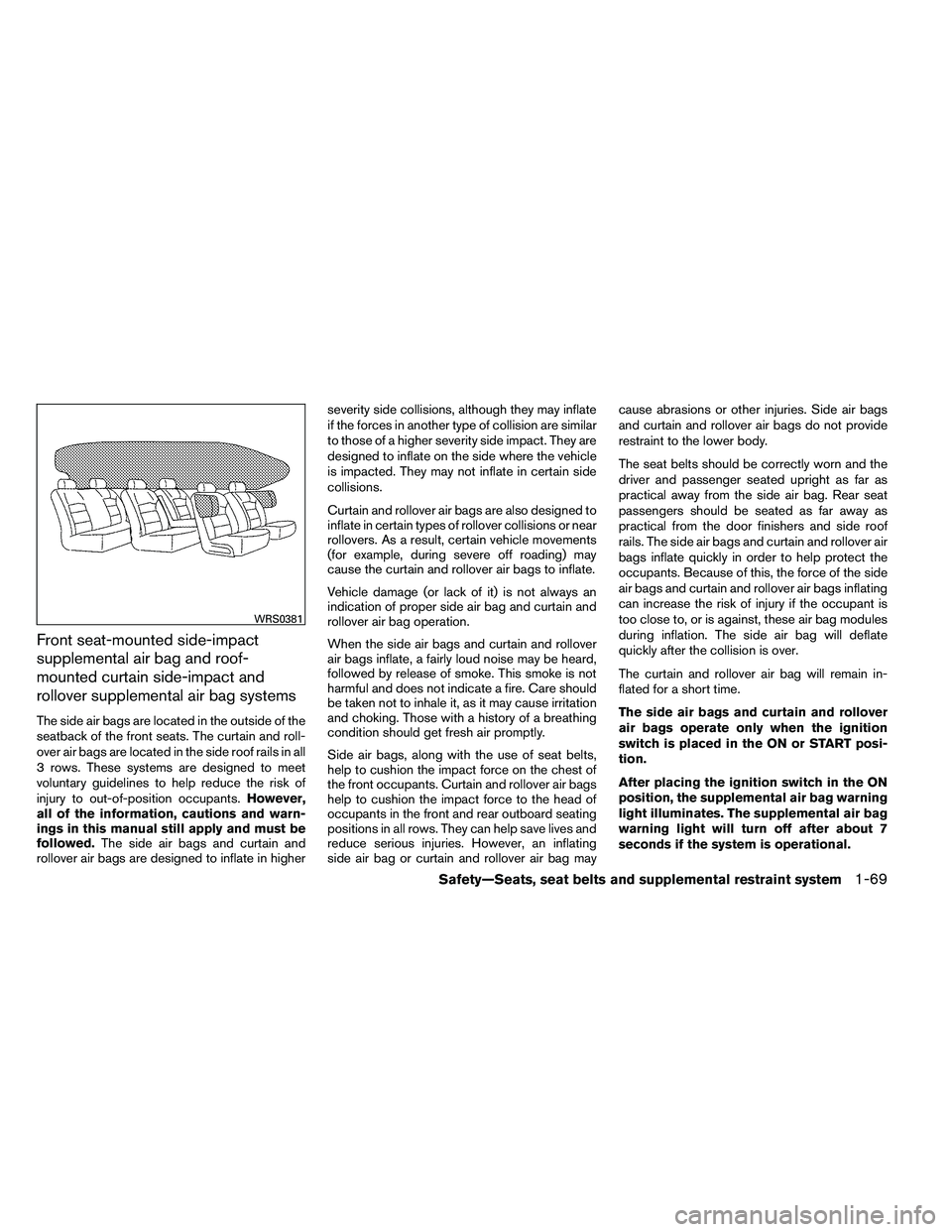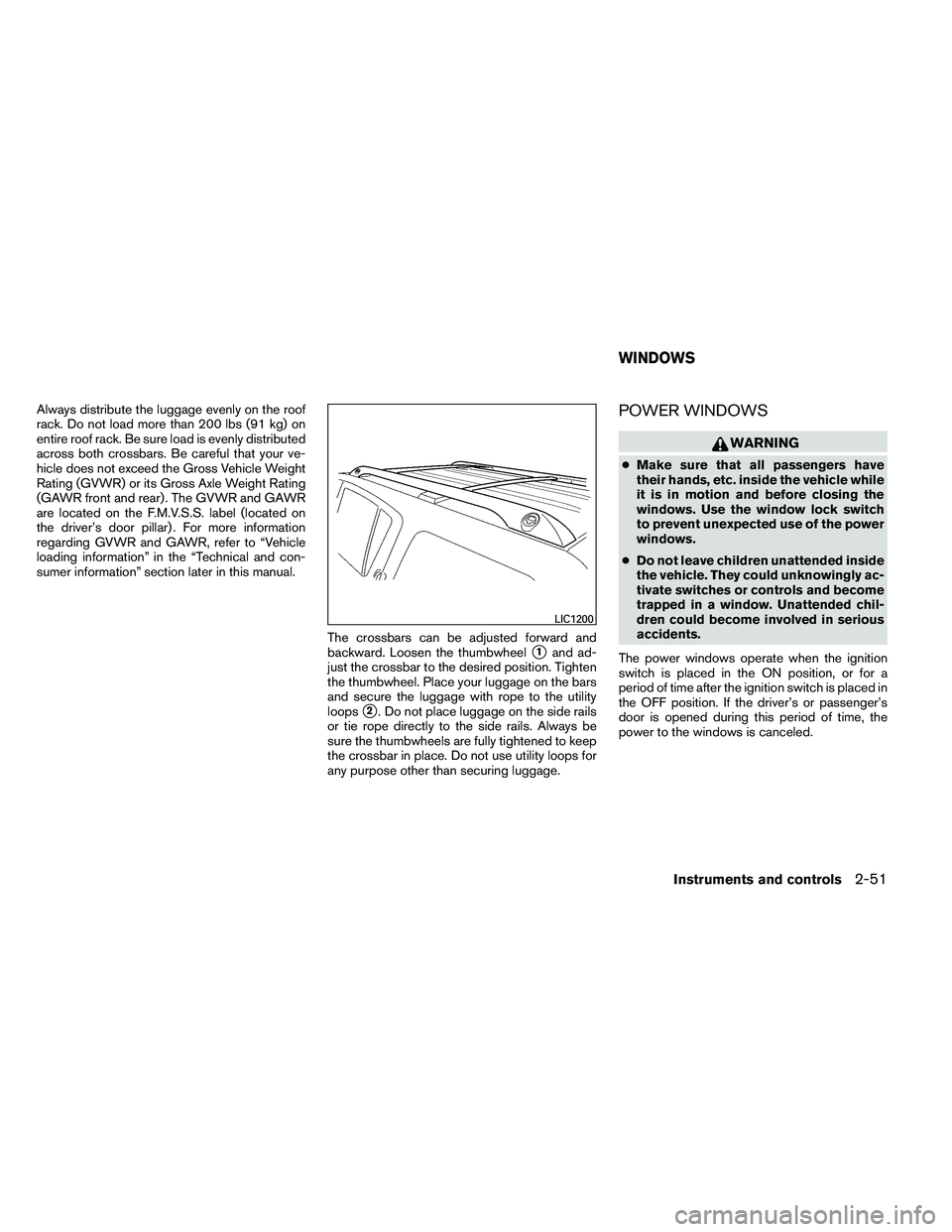Page 11 of 489
1. 3rd row bench seat belts (P. 1-25)
2. 2nd row seat belts (P. 1-25)
3. Roof-mounted curtain side-impact androllover supplemental air bag (P. 1-57)
4. Front seat belts (P. 1-25)
5. Head Restraints (P.1-8 )
6. Supplemental front-impact air bags
(P.1-57)
7. Seats (P. 1-2)
8. Occupant classification sensor
(pressure sensor) (P.1-64)
9. Seat belt with pretensioners (P. 1-70)
10. Front seat-mounted side-impact
supplemental air bag (P. 1-57)
11. LATCH (Lower Anchors and Tethers for
CHildren) (P. 1-38)
12. 2nd row seat top tether strap anchor
(P. 1-52)
13. 3rd row bench seat top tether strap
anchor (P. 1-53)
See the page number indicated in paren-
theses for operating details.
Page 13 of 489
1. Roof rack (P. 2-50)
2. Vehicle loading (P. 9-14)
3. Glass hatch (P. 3-28)
4. Rear window washer (P.2-29)
5. Glass hatch release (P.3-28)
6. Lift gate release (P. 3-27)
7. Rearview monitor (if so equipped)(P.4-33)
8. Replacing bulbs (P. 8-33)
9. Fuel-filler cap, fuel recommendation
(P. 3-28, P. 9-4, 9-5)
10. Fuel-filler door (P. 3-28)
11. Child safety rear door locks (P. 3-7)
See the page number indicated in paren-
theses for operating details.
Page 14 of 489
1. Rear ventilators (P. 4-35)
2. Storage (P. 2-40)
3. DVD entertainment system(if so equipped) (P. 4-77)
4. Moonroof (if so equipped) (P. 2-55)
5. Map lights (P. 2-58)
6. Sun visors (P. 3-31)
7. HomeLink� (P. 2-59)
8. Glove box (P. 2-42)
9. Seats (P. 1-2)
10. Cup holders (P. 2-44)
11. Luggage storage (P. 2-48)
See the page number indicated in paren-
theses for operating details.
Page 81 of 489
WARNING
●The seat belts, the side air bags and
curtain and rollover air bags are most
effective when you are sitting well back
and upright in the seat. The side air bag
and curtain and rollover air bag inflate
with great force. Do not allow anyone to
place their hand, leg or face near the
side air bag on the side of the seatback
of the front seat or near the side roof
rails. Do not allow anyone sitting in the
front seats or rear outboard seats to
extend their hand out of the window or
lean against the door. Some examples
of dangerous riding positions are
shown in the previous illustrations.
Page 83 of 489
1. Roof-mounted curtain side-impactsupplemental air bag inflators
2. Roof-mounted curtain side-impact and
rollover supplemental air bags
3. Air bag Control Unit (ACU)
4. Supplemental front-impact air bag
modules
5. Crash zone sensor
6. Occupant classification system control
unit
7. Occupant classification sensor
(pressure sensor)
8. Seat belt buckle switches
9. Seat belt with pretensioner
10. Satellite sensors
11. Front seat-mounted side-impact
supplemental air bag modules
NISSAN Advanced Air Bag System
(front seats)
This vehicle is equipped with the NISSAN Ad-
vanced Air Bag System for the driver and front
passenger seats. This system is designed to
meet certification requirements under U.S. regu-
lations. It is also permitted in Canada. However,
all of the information, cautions and warn-
ings in this manual still apply and must be
followed.
Page 88 of 489

Front seat-mounted side-impact
supplemental air bag and roof-
mounted curtain side-impact and
rollover supplemental air bag systems
The side air bags are located in the outside of the
seatback of the front seats. The curtain and roll-
over air bags are located in the side roof rails in all
3 rows. These systems are designed to meet
voluntary guidelines to help reduce the risk of
injury to out-of-position occupants.However,
all of the information, cautions and warn-
ings in this manual still apply and must be
followed. The side air bags and curtain and
rollover air bags are designed to inflate in higher severity side collisions, although they may inflate
if the forces in another type of collision are similar
to those of a higher severity side impact. They are
designed to inflate on the side where the vehicle
is impacted. They may not inflate in certain side
collisions.
Curtain and rollover air bags are also designed to
inflate in certain types of rollover collisions or near
rollovers. As a result, certain vehicle movements
(for example, during severe off roading) may
cause the curtain and rollover air bags to inflate.
Vehicle damage (or lack of it) is not always an
indication of proper side air bag and curtain and
rollover air bag operation.
When the side air bags and curtain and rollover
air bags inflate, a fairly loud noise may be heard,
followed by release of smoke. This smoke is not
harmful and does not indicate a fire. Care should
be taken not to inhale it, as it may cause irritation
and choking. Those with a history of a breathing
condition should get fresh air promptly.
Side air bags, along with the use of seat belts,
help to cushion the impact force on the chest of
the front occupants. Curtain and rollover air bags
help to cushion the impact force to the head of
occupants in the front and rear outboard seating
positions in all rows. They can help save lives and
reduce serious injuries. However, an inflating
side air bag or curtain and rollover air bag may
cause abrasions or other injuries. Side air bags
and curtain and rollover air bags do not provide
restraint to the lower body.
The seat belts should be correctly worn and the
driver and passenger seated upright as far as
practical away from the side air bag. Rear seat
passengers should be seated as far away as
practical from the door finishers and side roof
rails. The side air bags and curtain and rollover air
bags inflate quickly in order to help protect the
occupants. Because of this, the force of the side
air bags and curtain and rollover air bags inflating
can increase the risk of injury if the occupant is
too close to, or is against, these air bag modules
during inflation. The side air bag will deflate
quickly after the collision is over.
The curtain and rollover air bag will remain in-
flated for a short time.
The side air bags and curtain and rollover
air bags operate only when the ignition
switch is placed in the ON or START posi-
tion.
After placing the ignition switch in the ON
position, the supplemental air bag warning
light illuminates. The supplemental air bag
warning light will turn off after about 7
seconds if the system is operational.
Page 143 of 489
Page 144 of 489

Always distribute the luggage evenly on the roof
rack. Do not load more than 200 lbs (91 kg) on
entire roof rack. Be sure load is evenly distributed
across both crossbars. Be careful that your ve-
hicle does not exceed the Gross Vehicle Weight
Rating (GVWR) or its Gross Axle Weight Rating
(GAWR front and rear) . The GVWR and GAWR
are located on the F.M.V.S.S. label (located on
the driver’s door pillar) . For more information
regarding GVWR and GAWR, refer to “Vehicle
loading information” in the “Technical and con-
sumer information” section later in this manual.The crossbars can be adjusted forward and
backward. Loosen the thumbwheel
�1and ad-
just the crossbar to the desired position. Tighten
the thumbwheel. Place your luggage on the bars
and secure the luggage with rope to the utility
loops
�2. Do not place luggage on the side rails
or tie rope directly to the side rails. Always be
sure the thumbwheels are fully tightened to keep
the crossbar in place. Do not use utility loops for
any purpose other than securing luggage.
POWER WINDOWS